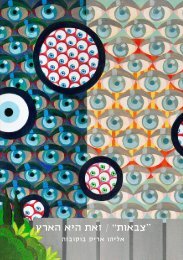eliahou eric bokobza ×ר×ק ××××× ××ק×××× eliya tsuchida ×××ת ××ר
eliahou eric bokobza ×ר×ק ××××× ××ק×××× eliya tsuchida ×××ת ××ר
eliahou eric bokobza ×ר×ק ××××× ××ק×××× eliya tsuchida ×××ת ××ר
You also want an ePaper? Increase the reach of your titles
YUMPU automatically turns print PDFs into web optimized ePapers that Google loves.
Eliya Tsuchida<br />
The Wedding Couple<br />
Digital print<br />
2005<br />
This couple’s wedding invitation embodies<br />
a connection that originates from a cultural<br />
inversion. Shirley from Israel is wearing a<br />
red kimono with a cranes print, while Japanese<br />
Eliya is wearing a kapote and a streimel.<br />
The kimono is the garment most identified<br />
with Japan, where the red color and the crane<br />
symbolize longevity and good luck. The Sakura<br />
(Japanese cherry) flower in the background<br />
refers to the season –spring. The kimono is<br />
wrapped around the body and fastened with a<br />
belt (obi). The kapote, a long, black, waistcoat,<br />
and the furry streimel hat, are typically worn<br />
by married orthodox Jewish men. In Japanese<br />
culture, the customary dress code requires the<br />
left side of the garment to be placed over its<br />
right side. In orthodox Jewry, the right side<br />
of the garment covers the left side, as a way<br />
to differentiate from the customs of gentiles.<br />
This confusion and inversion is presented by<br />
Tsuchida in a technique that characterizes<br />
Manga paintings: the characters’ features are<br />
exaggerated, their eyes appear round and large,<br />
they exhibit a big smile and an expression of<br />
wonder to render them cute. The teasing fingers<br />
that rise up behind Shirley’s head like two<br />
horns create a humoristic effect.<br />
The connection between Israel and Japan is<br />
expressed through flowers: the hibiscus that<br />
flourishes in the couple’s garden in Israel<br />
adorns Shirley’s hair; meanwhile, Japan’s<br />
national flower, the Sakura, decorates the<br />
Japanese tapestry which serves as a backdrop<br />
for the couple.<br />
אלי צוצ’ידה<br />
המתחתנים<br />
הדפס דיגיטלי<br />
2005<br />
הזמנת החתונה של בני הזוג מציגה חיבור מתוך היפוך<br />
תרבותי. שירלי הישראלית לובשת קימונו אדום מעוטר<br />
בהדפסי עגורים, אלי היפני לובש קאפוטה וחובש שטריימל.<br />
הקימונו הוא פריט הלבוש המזוהה ביותר עם תרבות יפן,<br />
הצבע האדום והעגור מסמלים בה אריכות חיים ומזל טוב.<br />
פרח הסאקורה )דובדבן יפני( ברקע מעיד על עונת השנה<br />
– האביב. הקימונו עוטף את הגוף ומוחזק בחגורה )אֹובִּ י(.<br />
הקאפוטה, מקטורן ארוך שחור, וכובע השטריימל הפרוותי<br />
מאפיינים את לבושם של גברים חרדים נשואים. קוד הלבוש<br />
המקובל בתרבות היפנית הוא שחלקו השמאלי של הבגד<br />
מונח על החלק הימני. ביהדות החרדית עוטים את צד ימין<br />
של הבגד על צד שמאל כדי להיבדל ממנהג הגויים.<br />
את העירוב וההיפוך מציג צוצ’ידה באמצעות מאפיינים<br />
של ציורי המנגה: הגזמה בתווי הפנים של הדמות, עיניים<br />
עגולות גדולות במראה פליאה וחיוך רחב ההופכים את<br />
הדמות לחמודה. תנועת ההקנטה של שליחת אצבעות קרניים<br />
מעל ראשה של שירלי יוצרת רושם הומוריסטי.<br />
החיבור בין ישראל ליפן נעשה באמצעות פרחים: פרח<br />
ההיביסקוס הצומח בגינת בני הזוג בישראל מעטר את<br />
שערה של שירלי; פרח הסאקורה, הפרח הלאומי של יפן,<br />
מעטר את הטפט היפני שעל רקעו צוירו הדמויות.<br />
10






